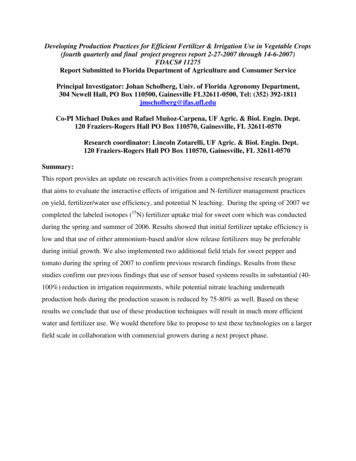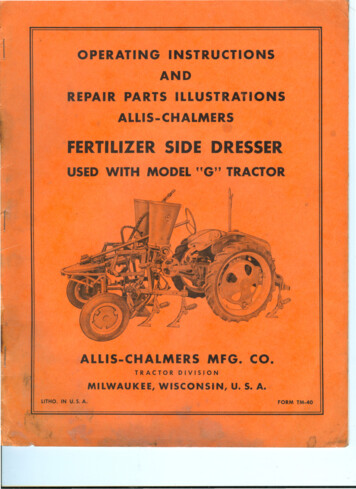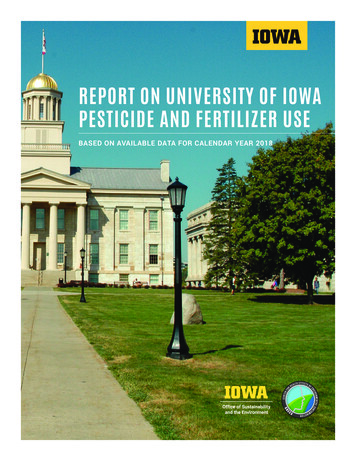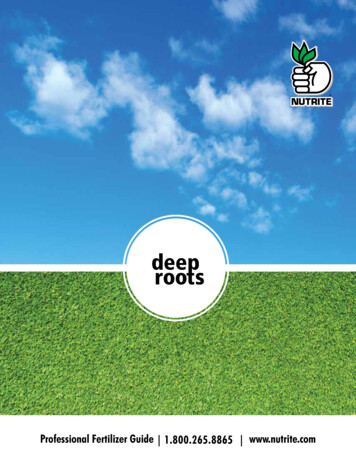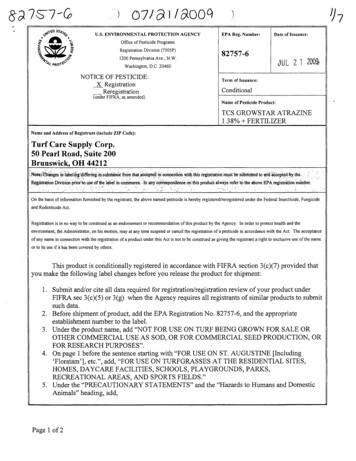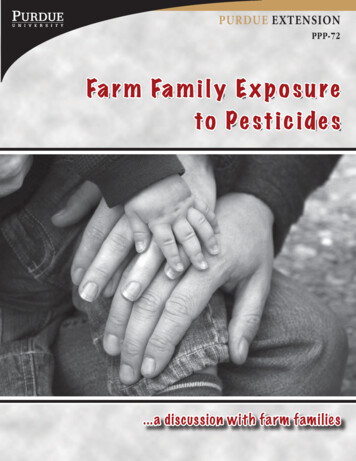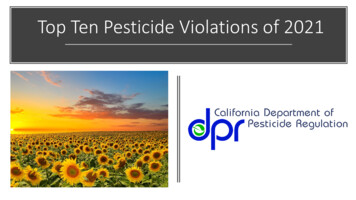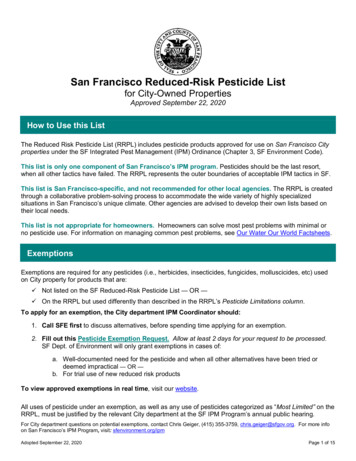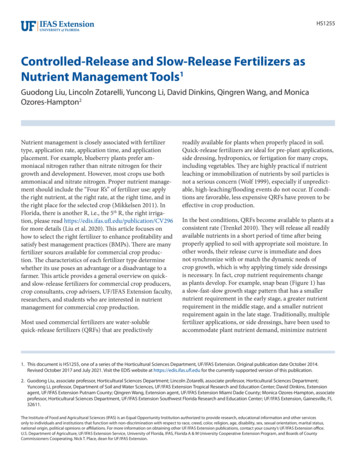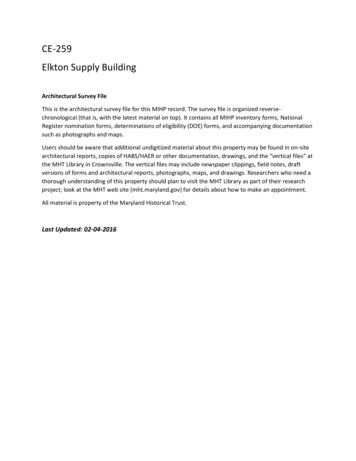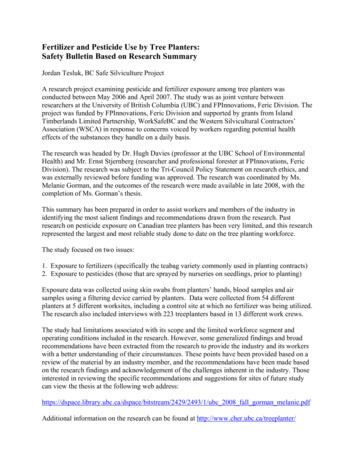
Transcription
Fertilizer and Pesticide Use by Tree Planters:Safety Bulletin Based on Research SummaryJordan Tesluk, BC Safe Silviculture ProjectA research project examining pesticide and fertilizer exposure among tree planters wasconducted between May 2006 and April 2007. The study was as joint venture betweenresearchers at the University of British Columbia (UBC) and FPInnovations, Feric Division. Theproject was funded by FPInnovations, Feric Division and supported by grants from IslandTimberlands Limited Partnership, WorkSafeBC and the Western Silvicultural Contractors’Association (WSCA) in response to concerns voiced by workers regarding potential healtheffects of the substances they handle on a daily basis.The research was headed by Dr. Hugh Davies (professor at the UBC School of EnvironmentalHealth) and Mr. Ernst Stjernberg (researcher and professional forester at FPInnovations, FericDivision). The research was subject to the Tri-Council Policy Statement on research ethics, andwas externally reviewed before funding was approved. The research was coordinated by Ms.Melanie Gorman, and the outcomes of the research were made available in late 2008, with thecompletion of Ms. Gorman’s thesis.This summary has been prepared in order to assist workers and members of the industry inidentifying the most salient findings and recommendations drawn from the research. Pastresearch on pesticide exposure on Canadian tree planters has been very limited, and this researchrepresented the largest and most reliable study done to date on the tree planting workforce.The study focused on two issues:1. Exposure to fertilizers (specifically the teabag variety commonly used in planting contracts)2. Exposure to pesticides (those that are sprayed by nurseries on seedlings, prior to planting)Exposure data was collected using skin swabs from planters’ hands, blood samples and airsamples using a filtering device carried by planters. Data were collected from 54 differentplanters at 5 different worksites, including a control site at which no fertilizer was being utilized.The research also included interviews with 223 treeplanters based in 13 different work crews.The study had limitations associated with its scope and the limited workforce segment andoperating conditions included in the research. However, some generalized findings and broadrecommendations have been extracted from the research to provide the industry and its workerswith a better understanding of their circumstances. These points have been provided based on areview of the material by an industry member, and the recommendations have been made basedon the research findings and acknowledgement of the challenges inherent in the industry. Thoseinterested in reviewing the specific recommendations and suggestions for sites of future studycan view the thesis at the following web ream/2429/2493/1/ubc 2008 fall gorman melanie.pdfAdditional information on the research can be found at http://www.cher.ubc.ca/treeplanter/
Key findings regarding fertilizeryHeavy metals are naturally occurring substances, and sampling found that trace amountswere detectable in the soils at the site, as well as the seedling root balls and fertilizers.yThere was no indication of heavy metal contamination in worker blood samples, and thehighest level of metal exposure was found at a worksite where fertilizers were not beingused.yNo heavy metals associated with fertilizers were found in the air samples.ySmall amounts of cadmium were found in three workers’ blood samples, but two of themhad not been handling fertilizer, and all three of them were smokers (smoking is a knownsource of cadmium exposure).yIn some instances, overall dust levels were a concern. However, the dust is likely fromwind blown soil and road dust rather than from the fertilizer.yAmmonia may be released from fertilizer when it becomes wet. Exposure to ammonia wasnot directly measured in this study, and it may warrant further examination in the future.yTree planters reported a higher than expected level of respiratory irritation symptoms, suchas coughs and phlegm. It is not possible to determine the potential cause of thesesymptoms through this research, but those who self-reported longer duration of work withfertilizer tended to be more likely to report work-related health effects. Tree plantersshould monitor their own personal health, and take whatever reasonably practicablemeasures they can to reduce their exposure to irritants, including smoke, dust, andchemicals.Key findings regarding pesticidesyPesticide residues were found on some seedlings. Levels were higher on trees that have hadmore recent applications of the substances prior to being planted.yPesticide residues were found on the skin of some tree planters. The amount of pesticidesfound on planters’ skin was determined to be far below what would be considereddangerous.yAlthough exposure levels found in this study were extremely low, workers should be awarethat exposure to pesticides can have harmful health effects, and workers should minimizeexposure through whichever reasonably practicable means are available. One commonlyused pesticide, chlorothalonil, has been classified by regulatory agencies as a probablehuman carcinogen.
yThe research could not control for every possible factor associated with exposure, butestimates based on maximum levels of exposure still indicate that the level of pesticideexposure experienced by the planters in the study does not pose a serious and immediaterisk to their health.yPoor hygiene and use of improper gloves can increase the level of pesticide and fertilizerexposure, and workers should be informed of better ways of protecting themselves andprovided with appropriate resources.yAlthough the levels of exposure for both pesticides and fungicides were below levelsconsidered harmful by several orders of magnitude, the substances applied to trees mayhave harmful health effects and workers can limit their exposure through the use ofpersonal protective equipment and proper hygiene procedures.Recommendations for minimizing exposureThese recommendations have been derived from the research, with additional content (photosand glove examples) added to help identify specific equipment and practices, and to place theresearch recommendations within the context of the work environment.yContractors should familiarize themselves with their responsibilities with respect tosupervising work with potentially hazardous substances, particularly regarding provision ofinformation, protective equipment, and opportunities for maintaining adequate personalhygiene.yTree planters work at an extremely high level of physical performance, and may bevulnerable to increased uptake of toxins. They should therefore exercise caution in regardsto all potential toxins, not only those potentially associated with pesticides and fertilizers.yWorkers should exercise particular caution when working with trees treated withchlorothalonil. Although estimated exposure levels were far below acceptable limits,chlorothalonil can have harmful health effects after heavy or prolonged exposure.Chlorothalonil is listed under various trade names including Bombardier, Bravo, Echo, andDaconil.yIt is important for workers to handle fertilizers properly, prevent spills, and minimizeabsorption into their clothing in order to reduce exposure.yDifferent bag materials are more effective at preventing leakage or transfer through thebags to the carrier. Butyl rubber, nitrile, and neoprene are some of the materials that wouldbe effective for carrying fertilizer. Carrying teabags loose in canvas planting bags orsilvacool bags does not offer effective containment.yContractors and workers should examine different methods and engineered receptacles forcarrying fertilizer in a way that reduces the amount of water contacting the fertilizerteabags, and minimizing spillage. Two models currently used in the field include
manufactured fertilizer pouches (picture 1), and the modified milk jug (picture 2). Both ofthese containers are designed to be attached to the belt of the planting bags. The goal ofthese designs is to prevent the fertilizer teabags from becoming wet, and to separate themfrom the body and other work gear.Picture 1Picture 2Image courtesy of Bushpro Supplies Inc.yWhen the same clothes are worn on consecutive planting days, contaminants can build upon the clothing. This can result in higher levels of exposure. Planting clothes should beworn only once, and then washed. Clothes should be washed in hot water to maximize thecleaning effect, and work clothes should be washed separately from casual clothes.yPlanters should change their clothes as soon as they get home. An extra long sleeve shirtfor changing into at the end of the day may be a useful piece of gear.yPlanters should wash their hands with soap and water as often as possible, especiallybefore eating, drinking, or smoking. Washing with water alone is not nearly as effective.Sanitary wipes and alcohol-based cleaners are effective at preventing the spread of germsand disease, but are not designed to remove dirt and chemicals from the skin.yThe industry may want to experiment with different methods of enabling hand washing,such as 3.5-gallon mobile hand wash stations or Scrub 'n Go Scrub Jug Minis. While suchoptions may not be practical in all tree planting work environments, other methods of handwashing in the tree planting environment warrant examination. For example, workers canbe encouraged to take a small vial of biodegradable soap to work. This can be used incombination with an extra bottle of water that can be poured over the hands (see picture 3),or with a camping style water jug with a faucet that can provide a stream of water (see
picture 4). Local water sources such as streams and creeks may also offer opportunities forworkers to wash their hands and reduce their exposure levels.Picture 3yPicture 4Industry (contractors) should implement adequate personal protective equipment programs.These programs should address the following issues.oContractors should train tree planters in the proper use and maintenance of theirgloves. For example, gloves should be changed if they become damaged orcontaminated on the inside and gloves should be washed prior to reuse.oDifferent glove materials work best for different chemicals. The contractor isrequired to tell tree planters what is required. Planters should use gloves that providea chemically impervious barrier. Nitrile, butyl rubber, or neoprene gloves should beused when handling fertilizers and pesticides. Latex does not provide an effectivechemical barrier. Examination of the ergonomic demands of gloves for tree plantingand the types of gloves most frequently used in the industry indicates that nitrile isthe most suitable material.
oWorkers should avoid using gloves that have open fabric backs (see pictures 5 and6), as they may trap chemicals and increase exposure levels by holding thecontaminated fabric against the skin.Picture 5Picture 6It has been noticed that many workers utilize open-backed gloves in combination with an innernitrile liner that covers the entire hand (see picture 7). This would provide better protection, butthe outer gloves should still be washed on a regular basis. There are also several types of nitrilegloves available for use that offer complete hand coverage along with suitable durability andergonomic design (see pictures 8 and 9).Picture 7Picture 8Picture 9A pamphlet has been prepared by the WSCA to provide employers and employees withimmediate recommendations for reducing worker exposure to pesticides and fertilizers. Thepamphlet includes information on hygiene and laundering work clothes, as well as a detailedguide on the types of gloves used in the industry.A note on responsibilityWhile many of the measures required to reduce exposure focus on the equipment used byindividual workers and their actions in the workplace, employers are responsible for properlyinforming workers of all foreseeable hazards and providing them with the knowledge and themeans to protect their health and safety. Employers must provide workers with the personalprotective equipment required for their job, and instruct them in regard to the care andmaintenance of that equipment. Employers are also responsible for ensuring that all worker
activities are in compliance with WorkSafeBC regulations and that workers are not engaging inpractices that are hazardous to their immediate or long-term health. This includes inspectingworkers to ensure they are using personal protective equipment such as proper gloves, andensuring that hazardous substances are being handled in a safe manner. Employers are alsorequired to implement WHMIS programs, and to provide the correct Material Safety Data Sheets(MSDS) for the substances being used at the worksite.Employers must acknowledge these requirements as they shape their health and safety policiesand programs. Maintaining a safe and healthy work environment is based on sharedresponsibility between the clear leadership of employers and the individual actions of theiremployees. This article has been provided to assist both employers and employees in fulfillingtheir roles in maintaining a safe and healthy workplace.The following people contributed to this research summary:yyyyDr. Hugh Davies (UBC School of Environmental Health)Mr. Ernst Stjernberg (Group Leader, Silvicultural Operations at FPInnovations, FericDivision)Ms. Melanie Gorman (research coordinator)Mr. Jordan Tesluk (BC Safe Silviculture Project)Article source: Gorman, M.J. 2008. Assessment of chemical exposure and self-reported healthamong tree planters in British Columbia. University of British Columbia.
were detectable in the soils at the site, as well as the seedling root balls and fertilizers. y There was no indication of heavy metal contamination in worker blood samples, and the . Nitrile, butyl rubber, or neoprene gloves should be used when handling fertilizers and pesticides. Latex does not provide an effective
